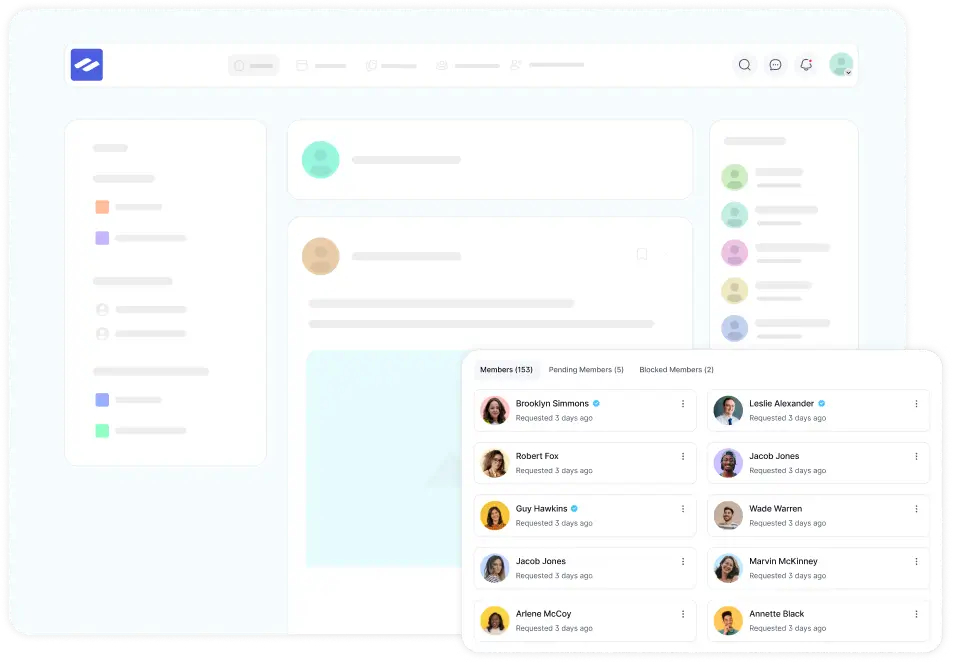Online Community 101: Everything You Need to Know
The Ultimate Beginner’s Guide to Building, Managing, Monetizing, and Growing Online Communities.
By Ashik Elahi, Marketing Strategist
Updated: April 08, 2024
|
24 min read

Want to turn your customers into loyal advocates, unite your supporters for a cause, or gather your course students in one place?
An online community is your answer—and we’re here to make it simple. In this article, we’re exploring everything you need to know about online communities: what they are, why they matter, and how to build, manage, grow, and even monetize one from scratch.
Whether you’re a business owner dreaming of a branded hub, an NGO rallying a movement, or an alumni group sparking lifelong bonds, this guide is your kickstart to creating a thriving digital space.
Let’s get started!
Introduction to the online community
Imagine a place where you can connect with people who get you—folks who share your passions, your questions, or even your quirks—no matter where they are in the world. That’s what an online community is all about.
So, what exactly is an online community by definition?
What is an online community?
At its core, the online community is a virtual space where people with shared interests, goals, or identities connect, communicate, and collaborate.
Whether it’s a group of gamers strategizing on Discord, parents swapping tips in a Facebook Group, or photographers critiquing shots on a forum, these communities thrive on interaction. You can jump in with a post, a comment, or a live chat—whatever sparks that sense of “Hey, I belong here!”
And the online community we’re talking about didn’t just appear overnight. It has evolved through different stages over the years. Let’s take a quick look at the journey!
A brief history of online communities & social networking
Online communities have changed significantly as the internet has developed, influencing how we meet people, exchange thoughts, and form bonds.
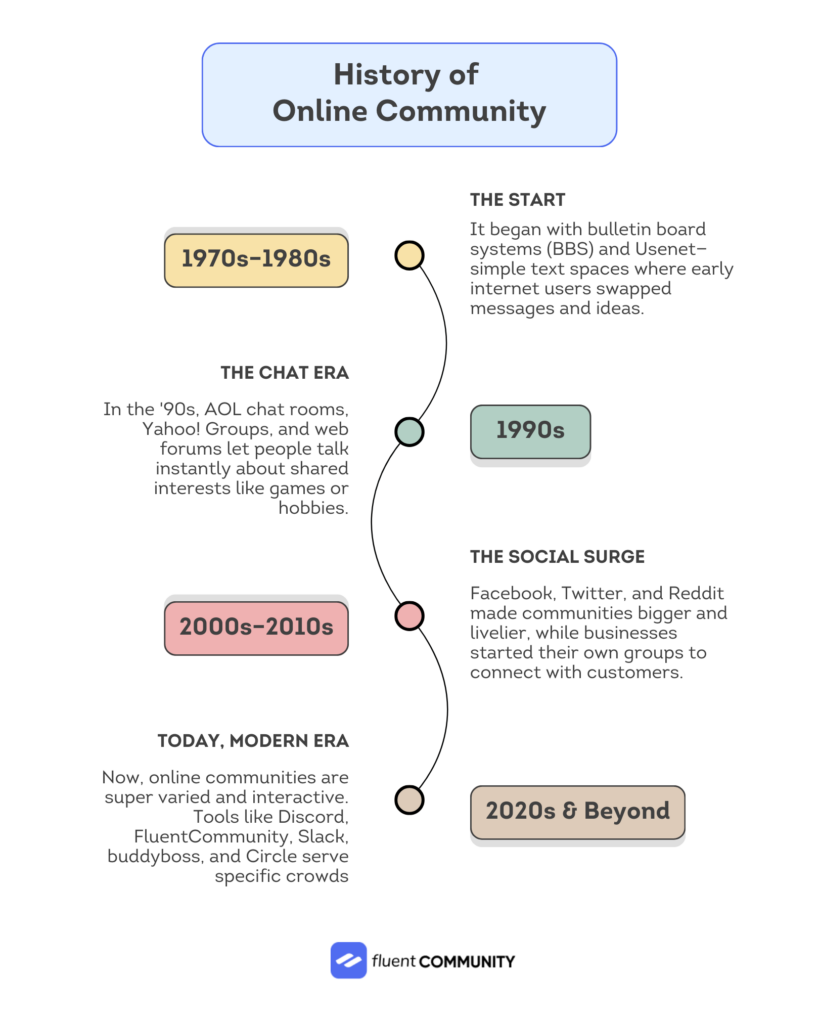
The start (1970s–1980s): It began with bulletin board systems (BBS) and Usenet—simple text spaces where early internet users swapped messages and ideas.
The chat era (1990s): In the ’90s, AOL chat rooms, Yahoo! Groups, and web forums let people talk instantly about shared interests like games or hobbies.
The social surge (2000s–2010s): Facebook, Twitter, and Reddit made communities bigger and livelier, while businesses started their own groups to connect with customers.
Today (2020s & beyond): Now, online communities are super varied and interactive. Tools like Discord, FluentCommunity, Slack, buddyboss, and Circle serve specific crowds—whether it’s gamers, coworkers, or enthusiasts—while businesses create private spaces, online courses, and forums to really bond with their people. With AI and fancy new tech, these communities keep getting more personal and exciting.
From text-based discussions to real-time video chats, online communities have transformed the way we connect—making the world feel smaller, more accessible, and more connected than ever before.
Read More: The History of Online Communities & Social Networking
Why are online communities important today
So, why should you care?
Because online communities are more than just places to chat — they’re where people belong. Whether you’re learning a new skill, finding like-minded people, or geeking out over a shared passion, these spaces give you a sense of connection beyond physical boundaries.
Imagine turning your passion into a thriving hub. That’s what online communities do — and in 2025, they’re more powerful than ever. With over 430 million people connecting on platforms like Reddit (Statista, 2024), communities have become the modern-day town square, where interests spark, and real conversations happen.
Unlike the shallow scroll of social media, online communities are built for depth. A 2022 Community Roundtable report found that 78% of members feel a stronger sense of connection in these spaces. Why? Because they’re driven by purpose, 65% join to learn, while 52% are drawn by shared interests (Higher Logic, 2023).
Take Duolingo forums, for instance: one in three users stick with Spanish thanks to the supportive community cheering them on (Duolingo Blog, 2023). And it’s not just about fun — it’s about growth. Communities drive loyalty for businesses, and creators are monetizing their spaces, with half of online communities expected to offer paid perks by the end of the year (Mighty Networks, 2024).
Big or small, public or private — online communities spark ideas, build connections, and keep people coming back. If you’re ready to build something that matters, this is your launchpad.
Now let’s explore the benefits of online community for business owners/entrepreneurs/NGOs and more.
Benefits of online communities for business
Think of a space where your customers don’t just buy your product but actively engage with it, talk about it, and even advocate for your brand. That’s the power of online communities.
Let’s dive into the top five reasons online communities can transform your business:
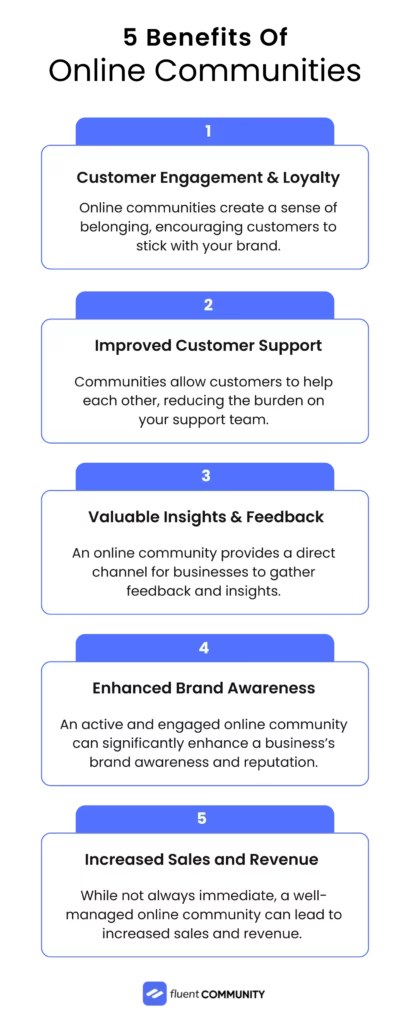
1. Customer engagement and loyalty
Online communities foster a sense of belonging, which is crucial for customer retention. By providing a space for customers to interact with each other and the brand, businesses can build stronger relationships that go beyond transactional interactions. This engagement often leads to increased loyalty, with customers more likely to return and recommend the business to others.
For example, Nike’s online community allows fitness enthusiasts to share their journeys, participate in challenges, and connect with like-minded individuals. This not only keeps customers engaged but also encourages them to stay loyal to the brand, leading to repeat purchases and word-of-mouth referrals.
2. Improved customer support
Online communities can significantly enhance customer support by enabling peer-to-peer help and reducing the workload on business support teams. Customers can ask questions, share experiences, and find solutions collaboratively, which can lower support costs and improve satisfaction.
For example, Apple’s Support Communities is a prime example, where users can find answers to their questions, share tips, and get assistance from both Apple staff and other users. This reduces the burden on Apple’s support team and provides faster, more efficient solutions to customer issues.
3. Valuable insights and feedback
An online community provides a direct channel for businesses to gather feedback and insights from their customers. This can be invaluable for understanding customer needs, preferences, and pain points, which can inform product development, marketing strategies, and more.
For example, Starbucks uses its online community to gather feedback on new products and services, helping them make data-driven decisions and improve customer satisfaction. This direct line to customer opinions can save time and money on traditional market research methods.
4. Enhanced brand awareness and reputation
An active and engaged online community can significantly enhance a business’s brand awareness and reputation. Community members often become brand advocates, spreading positive word-of-mouth and promoting the business to their networks, which can attract new customers and solidify the brand’s standing.
For example, The LEGO community is known for its enthusiastic members who not only buy LEGO products but also create and share their own designs, effectively promoting the brand through their creativity and passion. This organic promotion can enhance visibility and reputation.
5. Increased sales and revenue
While not always immediate, a well-managed online community can lead to increased sales and revenue. Through improved customer relationships, loyalty, and word-of-mouth recommendations, businesses can see a boost in sales from their community members, whether through repeat purchases or direct community interactions.
For example, Amazon’s Kindle Direct Publishing (KDP) community allows authors to connect, share tips, and promote their books, which can lead to increased sales for both the authors and Amazon. This demonstrates how communities can drive sales through stronger customer connections.
Now let’s discuss the different types of online communities.
Types of online communities
Types of online communities can be countless. Each type of online community might have its flavor, but they all share one superpower: connection. Whether you’re rallying fans around your brand, diving deep into a hobby, or supporting a cause, there’s a community-style that fits.
And here’s the kicker—you don’t have to pick just one! Some communities blend types, like a brand that adds learning perks or a local group with a support twist.
Let’s explore some of the most common kinds of online communities.
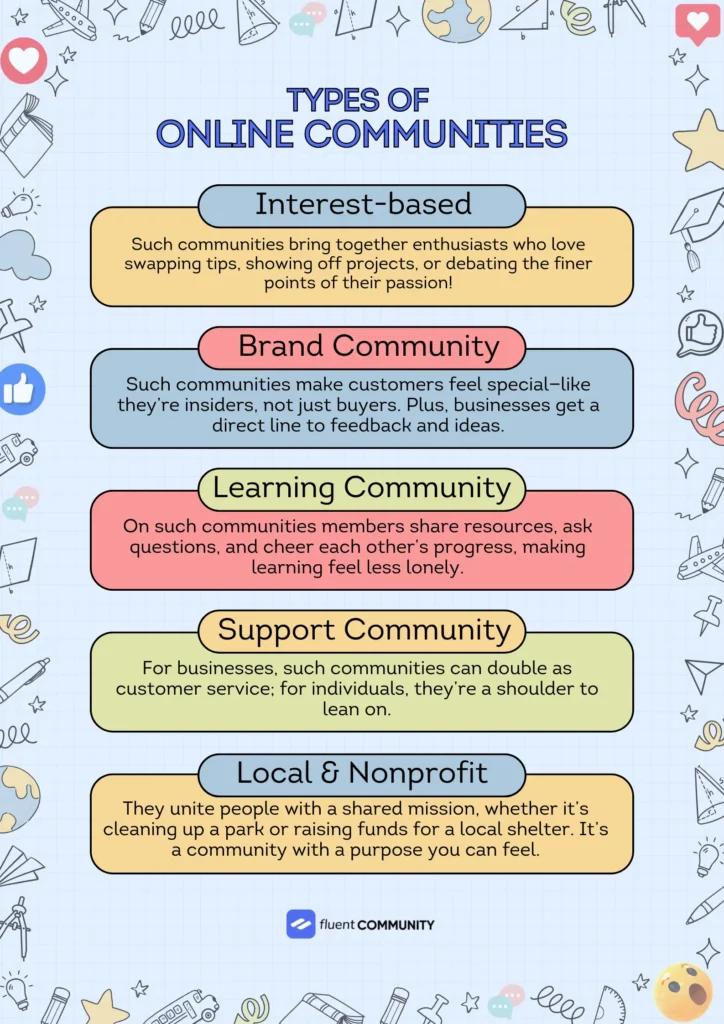
1. Interest-based communities
Interest-based communities are the go-to spots for people who geek out over the same hobbies, passions, or interests. Think of them as digital fan clubs where everyone’s obsessed with the same thing—whether it’s knitting, gaming, or sci-fi movies.
Such communities bring together enthusiasts who love swapping tips, showing off projects, or debating the finer points of their passion. It’s all about celebrating what makes you tick!
For example, Reddit’s r/photoshopbattles is a wild, creative hub where people remix images and cheer each other on. It’s pure fun fueled by shared creativity.
So, who’s it for? These types of communities are for anyone with a niche interest looking to connect with like-minded souls.
2. Brand communities
Brand communities are built around a company or product, turning customers into a tight-knit crew. It’s less about selling and more about creating a space where fans can chat, share, and feel part of the brand’s story.
They boost loyalty by making customers feel special—like they’re insiders, not just buyers. Plus, businesses get a direct line of feedback and ideas.
For example, Harley-Davidson’s H.O.G. (Harley Owners Group) is legendary—riders bond over their bikes, plan meetups, and live the Harley lifestyle. It’s a community that screams pride.
So, who’s it for? These types of communities are for businesses wanting to turn customers into raving fans.
3. Learning communities
These are all about growth and knowledge. They’re like online classrooms or study groups where people come to learn, teach, or sharpen their skills—think coding, cooking, or even mindfulness.
They’re a goldmine for anyone hungry to level up. Members share resources, ask questions, and cheer each other’s progress, making learning feel less lonely.
For example, Duolingo’s forums are buzzing with language learners swapping tips, practicing phrases, and celebrating milestones. It’s learning with a side of friendship.
So, who’s it for? These are especially great for students, professionals, or anyone chasing a new skill.
4. Support communities
These are safe havens where people lean on each other for help—whether it’s troubleshooting a gadget, navigating life’s challenges, or finding emotional support.
They’re a lifeline, offering answers and empathy when you need it most. For businesses, they can double as customer service; for individuals, they’re a shoulder to lean on.
For instance, the BabyCenter Community connects parents-to-be with advice on everything from diaper brands to sleepless nights. It’s real talk from real people.
Who’s It For? These are for anyone seeking solutions or solidarity—customers, patients, or everyday folks.
5. Local & nonprofit communities
These focus on bringing people together around a place or a cause—think neighborhood groups or charity-driven networks. They’re about making a difference, online and off.
They unite people with a shared mission, whether it’s cleaning up a park or raising funds for a local shelter. It’s a community with a purpose you can feel.
For example, Nextdoor connects neighbors to share updates, sell stuff, or plan events—it’s like a virtual block party that keeps the area tight-knit.
So, who’s it for? These are the Communities tied to a location or a passion for doing good.
Now let’s learn to build your first community online!
How to build an online community step-by-step
Building an online community can be one of the most rewarding ways to connect people.
Let’s walk through the essential steps to build an online community that lasts.

Step 1. Define your purpose and audience
Before you start building a community, ask yourself: Why does this community exist? Are you solving a problem, sharing expertise, or creating a support network? Defining your purpose from the beginning keeps your community focused and attracts the right people.
Next, identify who your community is for. Who are your ideal members? What motivates them? What challenges do they face?
For example:
- A freelance writers’ group might focus on career advice, networking, and industry insights.
- A gaming community could center around strategies, competitions, and game updates.
When you understand your audience, you can create a space that meets their needs and keeps them engaged.
Quick Tip: Summarize your purpose in one sentence, like: “Connecting fitness enthusiasts to share tips and motivation.”
Step 2: Choose the right platform
Now that you’ve got your purpose and people in mind, it’s time to pick the perfect spot for your community to live. The platform you choose shapes how everyone connects, so let’s look at some options:
- Facebook Groups: Awesome for laid-back, social hangs with tons of reach.
- FluentCommunity (WordPress Plugin): Your go-to if you want total control on your own social media.
- Discord: A fave for gamers, tech nerds, or tight-knit crews with live chats.
- Slack: Perfect for pro networks with slick productivity tools.
- Reddit or Forums: Great for deep-dive talks and knowledge hubs.
Pick one that aligns with your goals and where your audience would love to hang out. We’ll discuss how to choose an online community platform in the next section. Stay tuned!
Quick Tip: Test your top pick with a small crew before going all in.
Step 3: Set community guidelines
Now that you’ve chosen your platform, it’s time to establish some ground rules. Guidelines are the backbone of a positive community—they set expectations and keep interactions respectful and engaging.
Keep your rules simple and clear:
- Be respectful: Treat everyone with kindness and professionalism.
- Stay on topic: Keep discussions relevant to the community’s purpose.
- No spam: Avoid self-promotion unless allowed.
Foster a welcoming atmosphere:
We’re here to connect and grow—let’s make this a great space for all!”
Outline consequences for rule violations:
“Breaking the rules? You’ll get a warning. Repeated violations may result in removal.”
Well-defined guidelines prevent chaos and create a safe, inviting space for everyone. We’ll discuss more about this in the next section.
Quick Tip: Pin your community rules where members can easily find them, like in a welcome post or an announcement section.
Step 4: Set up the community structure
With your guidelines in place, it’s time to organize your community for smooth engagement. A clear structure helps members navigate easily and feel at home from day one.
Here’s how to set things up:
- Topics and Categories: Group discussions into relevant themes for easy browsing.
- Roles and Permissions: Assign moderators to keep conversations on track and assist members.
- Onboarding Process: Provide new members with a quick guide on how to participate.
A well-structured community acts like a roadmap, guiding members straight to valuable interactions.
Quick Tip: Create a “How to Get Started” post or guide to help newcomers dive right in.
Step 5: Launch and invite your first Members
With everything set up, it’s time to bring your community to life! Start small and strategic to build early engagement.
Here’s how to get your first members on board:
- Reach out to your existing network: Invite friends, followers, or loyal customers.
- Partner with influencers or brands: Utilize their audience to spread the word.
- Promote through content: Share in blog posts, emails, or social media.
- Welcome each new member personally: A simple “Hey, glad you’re here!” makes a difference.
- Break the ice: Start with a fun question like “What’s your favorite thing about [niche]?”
A strong launch sets the stage for a thriving, engaged community.
Quick Tip: Start with 10-20 members to spark conversations and build momentum.
Step 6: Keep creating engaging content
Your community is live—now it’s time to keep the conversation going! Content fuels engagement, so make sure there’s always something exciting happening.
Here’s how to keep members hooked:
- Share valuable content: Post articles, guides, or the latest industry news.
- Host interactive events: Try live chats, webinars, or Q&A sessions.
- Use polls and surveys: Find out what members care about and spark discussions.
- Encourage user-generated content: Ask members to share their own stories, tips, or ideas.
Consistency is key, keep posting regularly to remind members why they joined.
Quick Tip: Start with 2-3 posts per week, mixing your content with member contributions for variety.
Step 7: Encourage discussions and participation
You’ve got members—now it’s time to spark real conversations! A thriving community thrives on engagement, interaction, and shared experiences.
Here’s how to keep the discussions flowing:
- Ask thought-provoking questions: “What’s your biggest challenge in [niche]?”
- Run polls, challenges, or mini-contests: Make participation fun and rewarding.
- Highlight member achievements: Celebrate their wins, projects, or insights.
- Host interactive events: Try AMAs, expert hangouts, or live Q&As.
- Offer small incentives: Shoutouts, badges, or exclusive perks for active members.
The more people engage, the stronger and more connected your community becomes.
Quick Tip: Jump into discussions daily to keep the energy up and show members you’re listening!
Step 8: Moderate and maintain a positive environment
With your community buzzing, it’s essential to keep things friendly, respectful, and drama-free. Good moderation ensures a welcoming space where members feel valued and heard.
Here’s how to keep things running smoothly:
- Enforce guidelines fairly: Stick to the rules without playing favorites.
- Foster a respectful vibe: Encourage open discussions while keeping things civil.
- Nip spam and negativity in the bud: Remove unwanted posts before they spread.
- Lead by example: Be active, responsive, and set the right tone.
- Resolve conflicts calmly: Handle disagreements with patience and professionalism.
A well-moderated space makes members feel safe and eager to participate.
Quick Tip: Check in daily to moderate and engage—it shows you’re committed and keeps the community thriving!
Step 9: Grow and evolve your community
Your community is thriving—now it’s time to keep the momentum going and scale it up! Growth isn’t just about numbers; it’s about keeping things fresh and valuable.
Here’s how to expand and evolve:
- Gather feedback: Run surveys or casual check-ins to see what members love (or don’t).
- Introduce fresh topics or features: Adapt to new trends and member interests.
- Collaborate with brands or influencers: Leverage partnerships to reach a wider audience.
- Offer exclusive perks: Keep engagement high with VIP content, events, or special access.
- Stay ahead of trends: Keep an eye on what’s buzzing in your niche to keep things exciting.
A growing, evolving community keeps members engaged and attracts new ones.
Quick Tip: Check in monthly to refine what’s working and cut what’s not!
Let’s learn how to choose an online community platform easily!
How to choose an online community platform
So, you’re ready to build an online community—but before you start inviting folks in, you need to pick the perfect home for your community. Choosing the right platform is crucial, it needs to match your vibe, your crowd, and your goals.
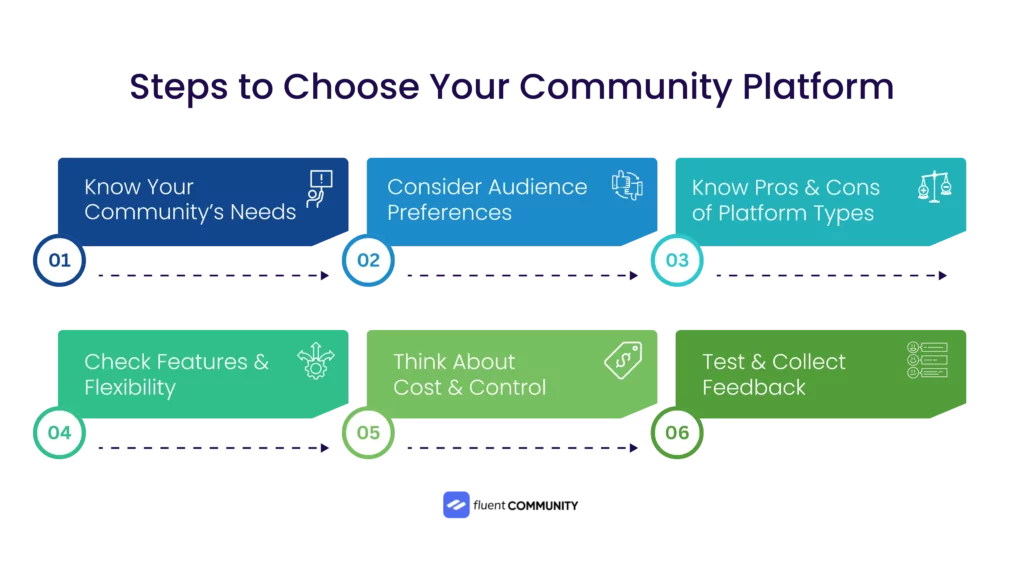
1. Know your community’s needs and goals
Before you dive in, take a step back and think: What’s the purpose of your community, and where do you want it to go? Are you planning casual chats, in-depth learning sessions, or a unique branded experience? Here’s how you can get started:
- List your must-haves: Do you need video uploads or a private space for members? Make sure to know what’s essential.
- Think ahead: Will you eventually add paid tiers or need to scale to thousands of members?
For example, a yoga community might require live class links, while a book club could just need discussion threads.
Choosing the right platform is like picking the perfect location for a barbecue—it’s all about matching the space to your needs. Once you get this right, everything else falls into place!
2. Consider your audience’s preferences
Your community’s success depends on understanding your members’ habits. Where do they spend their time online, and what tech do they prefer? Here’s how to figure it out:
- Ask yourself: Are they always on Instagram, or do they prefer forums? Do they enjoy using apps, or are they more comfortable with websites?
- Match their vibe: Busy moms might appreciate a Facebook Group, while gamers could prefer Discord.
For example, if your audience is young and mobile-first, an app like Circle might be a perfect fit.
Choosing a platform your members already use or can easily join is key. It’s like meeting them at their favorite coffee shop—it makes everything smoother and more inviting.
3. Weigh the pros and cons of platform types
When choosing a platform, you’ve got three main options: social media, standalone platforms, and custom sites. Each comes with its own benefits and challenges.
- Social Media (e.g., Facebook Groups): It’s free and easy to set up, but you’ll have limited control, and there are plenty of distractions.
- Standalone Platforms (e.g., Discord, Circle): These are built specifically for communities and are simple to set up, but they usually come with a monthly fee.
- Custom Sites (e.g., WordPress with FluentCommunity): You get full control and can customize the experience to match your branding, but it might take a little more effort to set up.
For example, if you’re running a casual hobby group, Facebook might be perfect. But if you’re offering a premium course, a platform like WordPress would give you more flexibility.
It’s like deciding between a potluck, a catered event, or a custom party—choose based on your audience and your style!
4. Check features and flexibility
Take a close look at what the platform offers. Does it have the community features you need now—and the flexibility to grow with you? Here’s how to make sure:
- Make a wishlist: Do you need forums, member profiles, payment options, or live events?
- Test the stretch: Can you add badges or integrate it with your email list?
For example, FluentCommunity on WordPress provides forums, community features, LMS, memberships, and more—all set to evolve as your community grows.
Features are what keep your community engaged—like a DJ, lights, and snacks at a party. If the platform is too basic, members may lose interest!
5. Think about cost and control
Consider how much you’re willing to spend and how much control you want over your community’s space. Here’s what to keep in mind:
- Free options: Platforms like Reddit are easy to start with, but you’re at their mercy when it comes to control.
- Paid platforms: Platforms like Circle charge a monthly fee (e.g., $30), giving you more control.
- Self-hosted (e.g., WordPress): This requires more upfront effort, but you have full control over everything. FluentCommunity keeps costs low.
For example, a startup might start with a free option, while a brand may prefer investing in WordPress for greater control.
This choice is like deciding between having your own property or renting a room—choose what fits your budget and vision.
6. Test and get feedback
Don’t just assume—test it out and listen to what your early members have to say. Here’s how to do it:
- Start small: Try your top two platform choices with a small group.
- Ask: “Is this easy and fun to use? What’s missing?”
- Adjust: If it’s clunky or lacks key features, make the switch.
For example, you might start with Discord, then move to WordPress if your members want more customization options.
Testing is your opportunity to iron out the kinks before your big launch!
Now that you’re familiar with the different platform options, don’t forget about WordPress—the world’s largest CMS. It’s a powerful choice for building your online community. Let’s dive into why WordPress might be your best platform for success.
Why should you consider a WordPress community builder?
WordPress powers over 43% of all websites, making it the most trusted & popular CMS worldwide. Its flexibility and extensive ecosystem allow you to create any type of online community, from social networks to membership sites.

Here’s why WordPress stands out:
- Full control & ownership: Unlike hosted platforms, WordPress lets you own your data, avoiding restrictions or unexpected shutdowns.
- Scalability: Whether you’re starting small or growing rapidly, WordPress handles increasing users and content effortlessly.
- Powerful community plugins: Plugins like FluentCommunity, BuddyPress, and bbPress transform WordPress into a feature-rich community platform.
- Customization & branding: Thousands of themes and plugins ensure a unique and branded experience without coding.
- SEO & performance: WordPress is built with SEO best practices and supports caching and performance optimization for fast-loading communities.
- Cost-effective: Unlike proprietary platforms, WordPress is free, and premium plugins provide affordable, scalable solutions.
By choosing WordPress, you get a customizable, scalable, and future-proof community without platform limitations.
As you’ve selected your preferred community platform, now’s the time to set rules to operate your community swiftly.
Read More: Introducing FluentCommunity: The Fastest Community Plugin for WordPress
How to create community guidelines
Let’s assume you’re launching an online learning community. You want it to be a place where everyone thrives, but without some ground rules, it could turn into a real mess. That’s where community guidelines come in to save the day!
Here’s how to craft guidelines that make your learning community a welcoming classroom without the stuffy feel. Think of it like setting up a study group where everyone’s excited to be there! Let’s get into this:
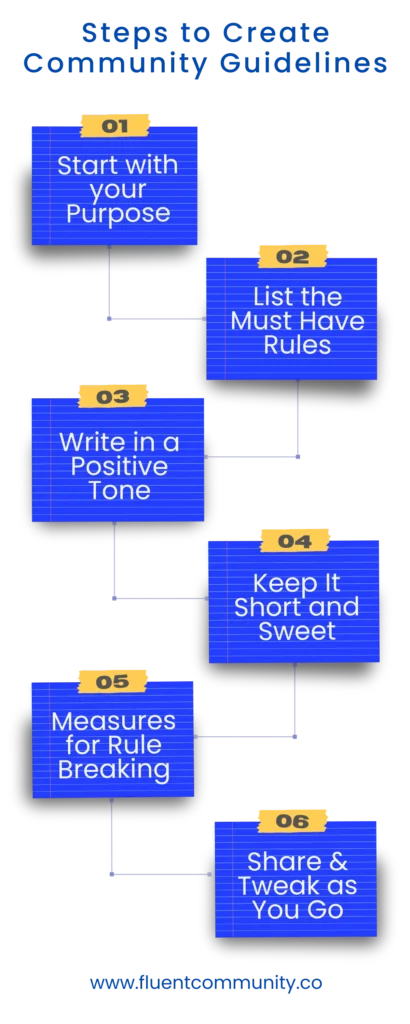
1. Start with your community’s purpose and vibe
Your community’s guidelines should reflect its purpose and the kind of atmosphere you want to create. Think of it like a supportive tutor rather than a strict principal.
Here’s how to do it:
- Nail your purpose: Make it clear—this is a space to learn Spanish together and have fun doing it.
- Set the tone: Create a warm, encouraging vibe that’s all about growth.
For example, we’re a team of Spanish learners here to practice, share, and grow—no pressure, just progress!
This makes your rules feel like a natural part of the learning experience—like a syllabus that actually makes you excited to study!
2. List the must-have rules
These guidelines help keep the learning on track and the space respectful. Focus on what encourages everyone to succeed.
Here’s how to do it:
- Encourage good vibes: Ask questions, share resources, and celebrate wins.
- Ban the buzzkills: No shaming, no off-topic posts, and no stealing credit.
For example, post your practice sentences, not your lunch pics—let’s keep it Español!
Clear rules create a safe environment for learning without distractions. It’s like keeping the chalkboard clean so you can focus on the important stuff.
3. Write with a warm, positive voice
Ditch the dry, formal tone. Your guidelines should feel like a pep talk from a cool teacher.
Here’s how to do it:
- Use “we” for unity: We’re all in this together—let’s lift each other up!
- Add some cheer: Mistakes? No worries—that’s how we grow!
For example, we love seeing your progress, so don’t be shy—share away!
A friendly tone makes the rules feel like a team effort, not a lecture. It’s like a high-five instead of a finger-wag!
4. Keep it short and sweet
Learners are busy, give them guidelines so they can quickly skim and still understand.
Here’s how to do it:
- Use bullets:
- Be kind to everyone.
- Stick to Spanish topics.
- No mean comments.
- Be kind to everyone.
- Skip the fancy words: “Help out” beats “Facilitate collaboration.”
Short, simple rules will stick in their heads while they’re conjugating verbs. It’s like a quick study note, not a textbook chapter.
5. Explain what happens if rules are broken
Make sure everyone knows the rules and how to handle problems when they arise.
Here’s how to do it:
- Keep it fair: Break a rule once? We’ll chat. Keep it up? You’ll take a short break.
- Offer support: If you spot something off, let a moderator know—we’ll handle it.
For example, break the rules? We’ll give you a nudge; repeat, and you’ll take a short break.
This helps build trust and maintain peace like a referee making sure the game stays fair.
6. Share and tweak as you go
Launch your guidelines, gather feedback, and adjust as your learners grow and new needs arise.
Here’s how to do it:
- Post them proudly: Pin your guidelines to your forum or welcome page.
- Ask: “Hey learners, do these work for you?”
- Update: If memes are taking over, add something like “Keep it learning-focused.”
Flexible rules evolve with your community, just like adding new lessons as your class levels up.
How to manage an online community
So, you’ve gone through every essential step to build an online community, and now people are showing up; chatting, sharing, connecting. It’s exciting, right? But now comes the real adventure: keeping it running smoothly.
Don’t worry, it’s totally doable. Here’s how to keep your community thriving day in and day out.
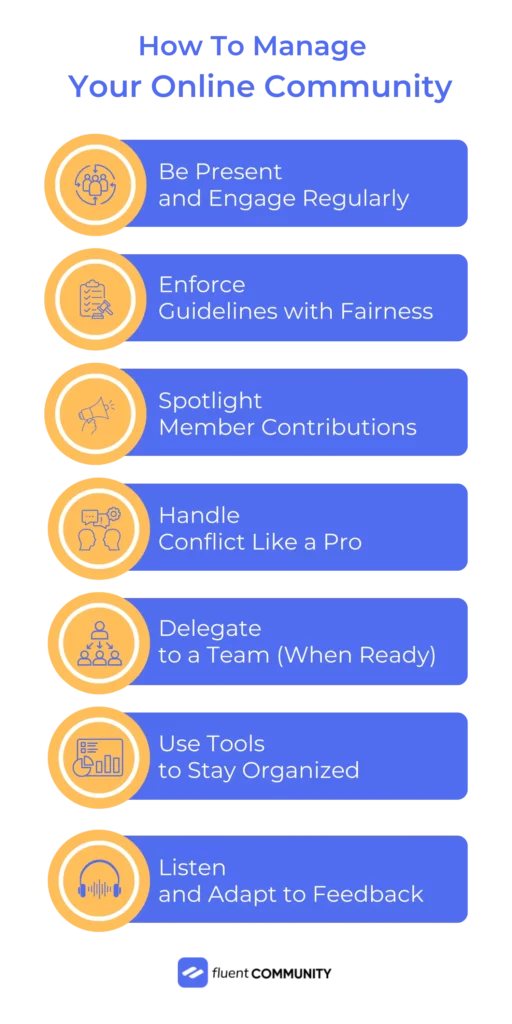
1. Be present and engage regularly
You’re the heartbeat of the community. Show up, chat, and set the tone. Your presence keeps things lively.
- Pop in daily: Reply to a post, ask a question, or share a quick thought. For example, “What’s your weekend plan, crew?”
- Be human: Share a laugh or a personal tidbit. For example, “I just spilled coffee all over my desk, oops!”
For example, in a baking community, you could post, “Tried a new cookie recipe—total win! What’s your go-to?”
Members stick around when they see you care. It’s like being a host at a party, mingling with everyone instead of hiding in the kitchen.
2. Enforce guidelines with fairness
Rules aren’t just for show; they help maintain peace, but they should be enforced fairly, not harshly.
- Watch for trouble: Spot spam, rudeness, or off-topic posts early.
- Act calmly: Start with a private warning, like, “Hey, let’s keep it friendly, okay?” Then escalate if needed, like giving a timeout.
- Stay consistent: Treat everyone the same—no favorites.
For example, if someone posts an ad in a pet community, say, “Love your enthusiasm, but promos need approval—check our guidelines!”
Fair enforcement builds trust and keeps the community running smoothly—like a referee maintaining the game’s flow without ruining the fun.
3. Spotlight member contributions
Highlight your members’ contributions to keep them motivated and feeling appreciated.
- Shout out wins: “Big props to Mia for her epic sourdough pic!”
- Feature content: Pin a great post or share it in your newsletter.
For example, in a photography group, you might say, “Check out Jake’s sunset shot—pure magic! What’s your favorite technique?”
Recognition boosts engagement. It’s like handing out party favors that make everyone smile.
4. Handle conflict like a PRO
Disagreements happen, manage them quickly and kindly to keep the community’s vibe intact.
- Step in early: If you spot a heated thread, jump in with something like, “Let’s cool it down and focus on the topic, folks!”
- Go private: Message the troublemakers separately, “Hey, saw your comment—can we chat?”
- Resolve, don’t punish: Aim to fix the issue, not ban people, unless the behavior is toxic.
For example, if two members are arguing about dog training, you could say, “Love the passion—let’s share tips, not clash!”
Good conflict management keeps the community a safe space, like smoothing over a spat at a family dinner.
5. Delegate to a team (When ready)
As your community grows, you can’t do it all on your own; bring in helpers to share the load.
- Pick active members: Look for people who already pitch in and understand the vibe.
- Assign roles: Moderators to enforce rules, greeters to welcome newcomers, or content creators to keep posts fresh.
For example, in a gaming community, you could make Sarah a mod to oversee chats and Tom a greeter to welcome new players.
A team helps everything run smoothly without burning you out!
6. Use tools to stay organized
Utilize technology to manage posts, members, and chaos without losing your mind.
- Moderation tools: Use auto-filters to block spam or flag inappropriate words.
- Analytics: Track what’s popular; posts, active times—and use that data to plan better.
For example, with FluentCommunity on WordPress, you can auto-filter, manage memberships, and track engagement all in one place.
Tools are your sidekick, saving time and keeping everything running smoothly, like a party planner app for your big bash.
7. Listen and adapt to feedback
Your community is always evolving, so make adjustments based on what members need.
- Ask often: “What’s working? What’s not? Tell us!”
- Act on it: If members want more Q&As, host one. If they hate clutter, clean it up.
For example, members in a craft group might say it’s too quiet. You could start a “Project of the Week” thread to spark engagement.
Listening keeps members happy and invested, like changing the music when the crowd isn’t dancing.
Managing an online community isn’t about being the boss. It’s about being the glue. Show up, keep it fair, celebrate your people, and handle any hiccups with grace.
Read More: All You Need to Know About Community Management
How to grow a community online
You’ve launched your online community. But now you want more: more members, more excitement, more influence. So, how do you make that happen?
Here’s how you can grow your community’s size and spark, with simple steps to attract new people and keep them engaged.
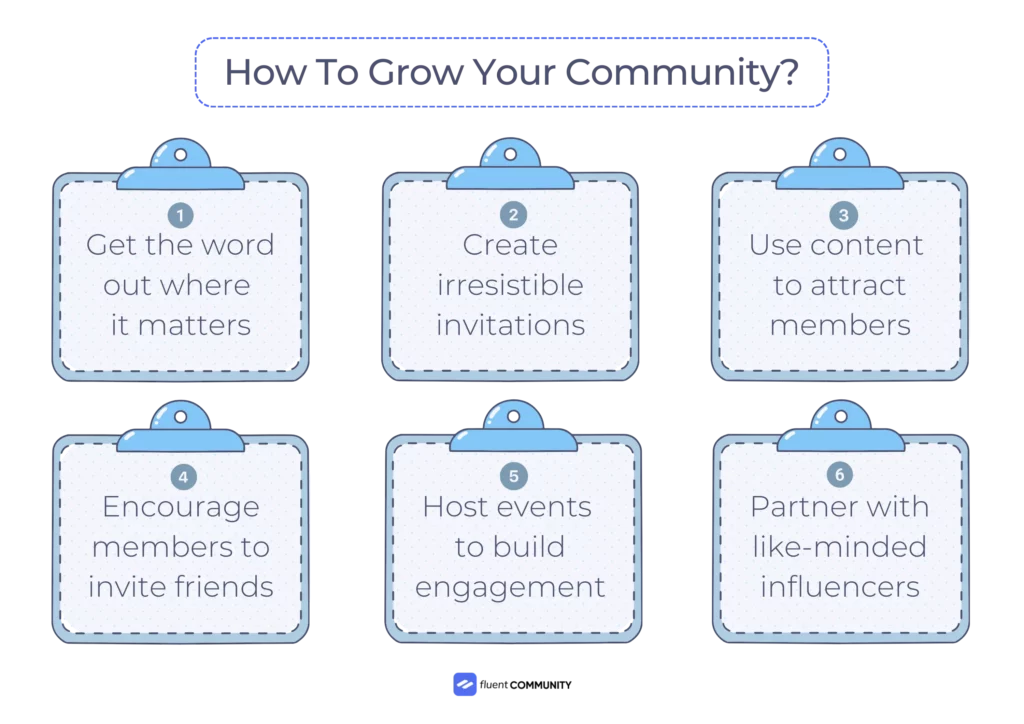
1. Spread the word where your people hang out
Growth starts with visibility. You need to go where your ideal members already spend their time and invite them in.
- Leverage social media: Post engaging teasers like, “Love sci-fi? Join our crew!” on platforms like Twitter, Instagram, or TikTok.
- Engage with related communities: Share your community in relevant groups or forums (with permission), like Reddit’s r/scifi.
- Use content to attract: For a fitness community, post a short workout tip video with a call to action—“Want more? Join us!”
Reaching people where they already hang out increases your chances of attracting the right members.
2. Create irresistible invitations
Make joining your community an easy and exciting decision with a clear and compelling invitation.
- Highlight the benefits: “Get insider tips, connect with pros, and have fun—join our photography fam!”
- Make it personal: “I started this for people like us—come say hi!”
- Use direct outreach: Send an email like, “Hey, I’ve built a space for dog lovers like you—ready to swap pup pics?”
A great invite feels like an exclusive event—make it engaging, and people will want to join.
3. Use content to attract members
Content is a powerful way to showcase your community’s value and bring in new people.
- Share valuable resources: Offer a free “Top 5 Gardening Hacks” guide with a message like, “Get more in our group!”
- Use visuals: Post a meme or video that captures your community’s vibe—“This is us—join the fun!”
- Leverage niche interests: If you run a cooking group, share a quick recipe reel on Instagram with “Love this? Our members share more daily!”
Compelling content acts as a magnet, drawing in the right audience.
4. Encourage members to invite friends
Your current members can be your best ambassadors.
- Ask directly: “Loving this space? Bring a friend and grow with us!”
- Offer small incentives: “Invite three friends and earn a shoutout or badge!”
- Make it fun: In a gaming group, say, “Bring your squad—we’re stronger together!”
Word-of-mouth recommendations are powerful because new members come in already excited.
5. Host events or challenges to build engagement
Interactive events create excitement and encourage participation.
- Run simple challenges: Try a “Photo of the Week” contest or a live Q&A.
- Create urgency: “Join our 7-Day Fitness Challenge—starts Monday!”
- Engage through storytelling: A writing community could host “Flash Fiction Friday”—“Submit your 100-word story and join the fun!”
Events act as a spotlight, drawing attention and sparking community activity.
6. Partner with like-minded communities or influencers
Collaboration helps you reach a wider audience without starting from scratch.
- Find complementary partners: A craft group could team up with a DIY blog or Instagram influencer.
- Cross-promote: Co-host a webinar or do mutual shoutouts—“Check out our friends over here!”
- Utilize niche influencers: A language-learning community might collaborate with a travel vlogger—“Learn Spanish with us, then plan your trip!”
Strategic partnerships allow you to tap into an existing audience that shares your interests.
Growing a community takes time, but with the right strategies, you can attract engaged members who add value and keep the momentum going.
How to monetize an online community
What if your passion project could also bring in some income? Monetizing your community isn’t just about making money; it’s about adding value for your members while keeping the energy alive.
Here’s how you can turn your community into a revenue stream, with practical tips anyone can use. The key is balance; earning money while keeping your members happy.
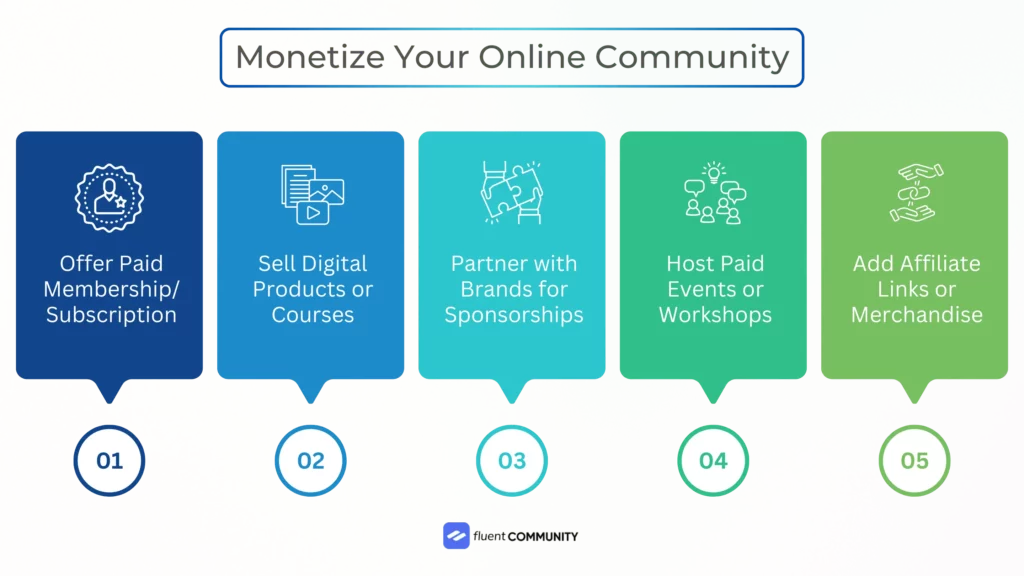
1. Offer paid memberships or subscriptions
Charge a fee for access to exclusive perks like premium content, special events, or a VIP area. It’s like giving your biggest fans a backstage pass. To do so:
- Set tiers: Offer different levels, such as $5/month for basic access and $15/month for extras (e.g., live Q&As).
- Highlight value: Promote your unique offerings, like, “Unlock expert-led webinars and our secret recipe vault!”
- Use tools: Platforms like FluentCommunity on WordPress make setting up membership tiers simple.
Members are willing to pay for something extra, and you get a consistent stream of income. For example, a fitness community might charge for exclusive workout plans—everyone benefits!
For example, the “Yoga with Adriene” community offers a paid tier for deeper yoga content. This allows them to keep the free content accessible while rewarding supporters with extra perks.
2. Sell digital products or courses
Create and sell products your members will love, such as e-books, templates, or full courses based on your community’s interests.
- Find their needs: For example, a photography group might want a “Lighting 101” guide.
- Keep it simple: Start small with a $10 e-book or a $50 mini-course.
- Promote naturally: Try something like, “Hey, shutterbugs! Grab our new editing cheatsheet!”
You’re offering tools your members want, and the best part is—it’s a one-time effort with ongoing sales. It’s like selling snacks at a movie night—easy and in-demand!
For example, a coding community could create and sell a “Python for Beginners” course, catering directly to what their members are there to learn.
3. Partner with brands for sponsorships
Partner with companies that align with your community’s interests to sponsor posts, events, or features. Think of it like having a cool guest drop by with special goodies for everyone.
- Pick relevant brands: For instance, a gardening community might partner with a seed company.
- Offer value: “Sponsor our next plant swap, and we’ll give you a shoutout to 1,000 growers!”
- Keep it chill: Limit sponsored posts to about one a month, so it doesn’t overwhelm your members.
Brands pay for exposure, and members get perks like discounts or freebies. It’s a win-win without feeling salesy.
For example, a gaming community might partner with Razer to sponsor a tournament, which boosts both engagement and cash flow.
4. Host paid events or workshops
Charge for special online events like webinars, live tutorials, or Q&A sessions with experts your members admire.
- Plan something epic: “Join our $20 sourdough baking workshop!”
- Use community input: Ask members what they’d pay to learn or experience.
- Record it: Sell replays for those who couldn’t make it live.
It’s a one-time fee for a unique experience, and members enjoy the live interaction. It’s like buying a ticket to an event they won’t want to miss!
For example, a writing community could host a “Pitch Your Novel” workshop with an editor for $30 a spot.
5. Add affiliate links or merchandise
Earn a commission by recommending products your members would love or sell branded gear, like T-shirts or mugs, that they’d proudly wear or use.
- Affiliates: Share links to products, like “Love this camera? Grab it here on Amazon!”
- Merch: Design a logo and sell items like “Official Coffee Lovers Club” mugs.
- Be subtle: Include recommendations naturally—don’t overwhelm members with constant promos.
It’s a low-effort way to earn income that aligns with your community’s interests—like suggesting a great coffee blend to coffee lovers.
For example, a travel community could earn by sharing hotel booking links or selling “Wanderlust Warrior” hoodies.
4 common online community challenges
Building an online community is exciting, but challenges are inevitable. Don’t worry—every community faces roadblocks. Here are four common issues and simple ways to fix them so your group stays active and thriving.
1. Low Engagement
Your community posts aren’t getting responses, and the group feels quiet. To fix this:
- Start discussions with engaging questions like, “What’s your go-to coffee hack?”
- Run polls or interactive posts to encourage participation.
- Highlight active members to motivate others.
A little push helps turn silent members into active contributors, making the community feel lively and inviting.
2. Spam & Moderation Issues
Your community is getting flooded with spam, self-promotion, or off-topic rants. To fix this quickly:
- Set clear guidelines like, “No spam or unapproved promotions.”
- Use moderation tools like FluentCommunity’s spam filters to block unwanted content.
- Warn repeat offenders privately before taking stricter action.
A well-moderated space keeps conversations meaningful, making members feel safe and valued.
3. Member Retention Struggles
People join but don’t stick around, and your community growth stalls. To overcome this–
- Personally welcome new members with a friendly message.
- Share something valuable upfront, like a pro tip or an invite to an upcoming event.
- Create a “Start Here” guide so they know how to engage.
When people feel noticed and immediately find value, they’re more likely to stay. It’s like making a great first impression at a party!
4. Scaling Difficulties
Your community is growing fast, but managing it feels overwhelming. Do these as follows:
- Bring in moderators to help keep things organized.
- Create sub-groups or categories, like “Beginners” and “Experts,” so discussions stay relevant.
- Use tools like FluentCommunity to streamline management and automate tasks.
A structured approach keeps the community engaging and manageable. Growth stays exciting, not exhausting!
Conclusion
There you have it, your all-in-one roadmap to online community success! We’ve explored how to craft a space that connects your people, from defining your purpose and picking the perfect platform (like FluentCommunity on WordPress) to sparking engagement, scaling growth, and even turning it into a revenue stream.
Whether you’re a business owner boosting loyalty, an NGO driving impact, or an alumni group reviving ties, you now know the steps to build something meaningful. With the right strategy and a little dedication, your community can grow into a vibrant, engaged space that lasts.

Marketing Strategist
Ashik Elahi is a seasoned Digital Marketing Strategist with a passion for Content Marketing. He believes in the power of storytelling and crafting valuable content that resonates with readers.
Table of Content
Subscribe To Get
WordPress Guides, Tips, and Tutorials

